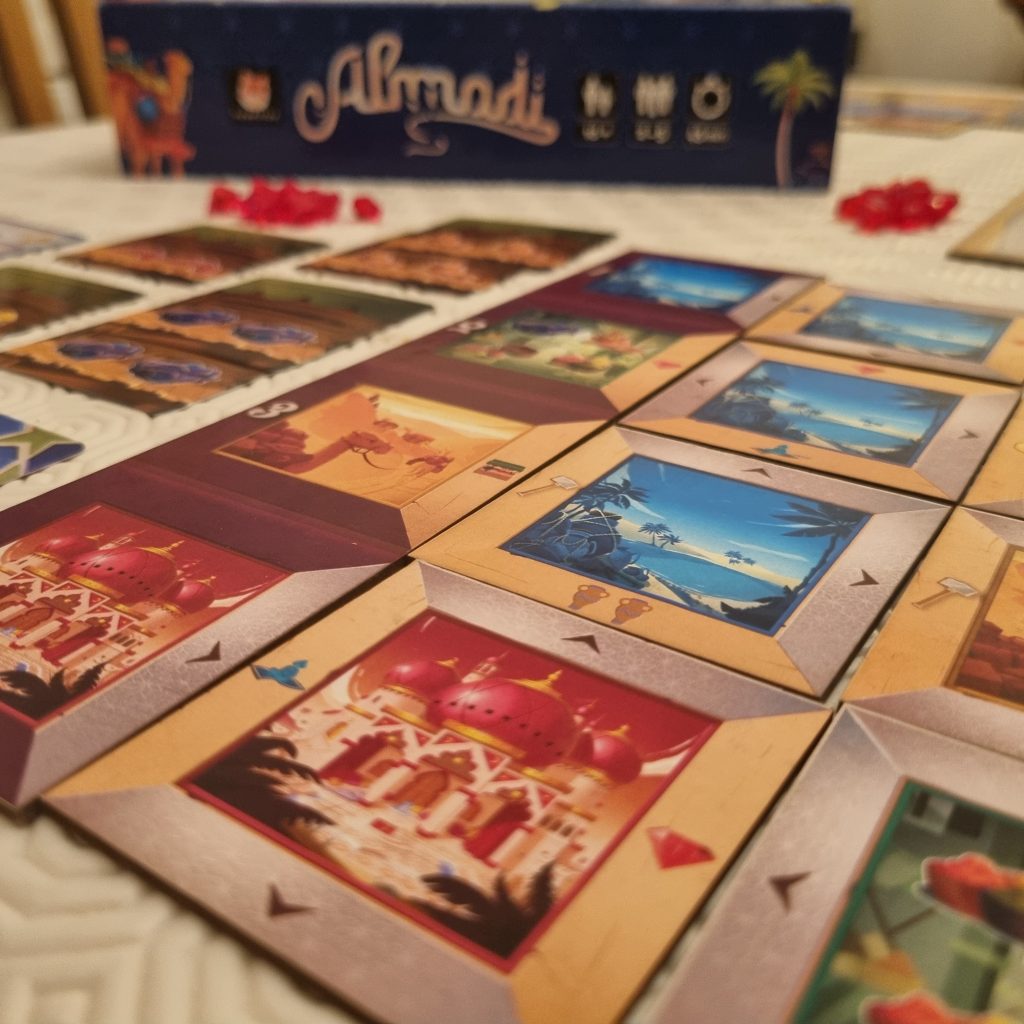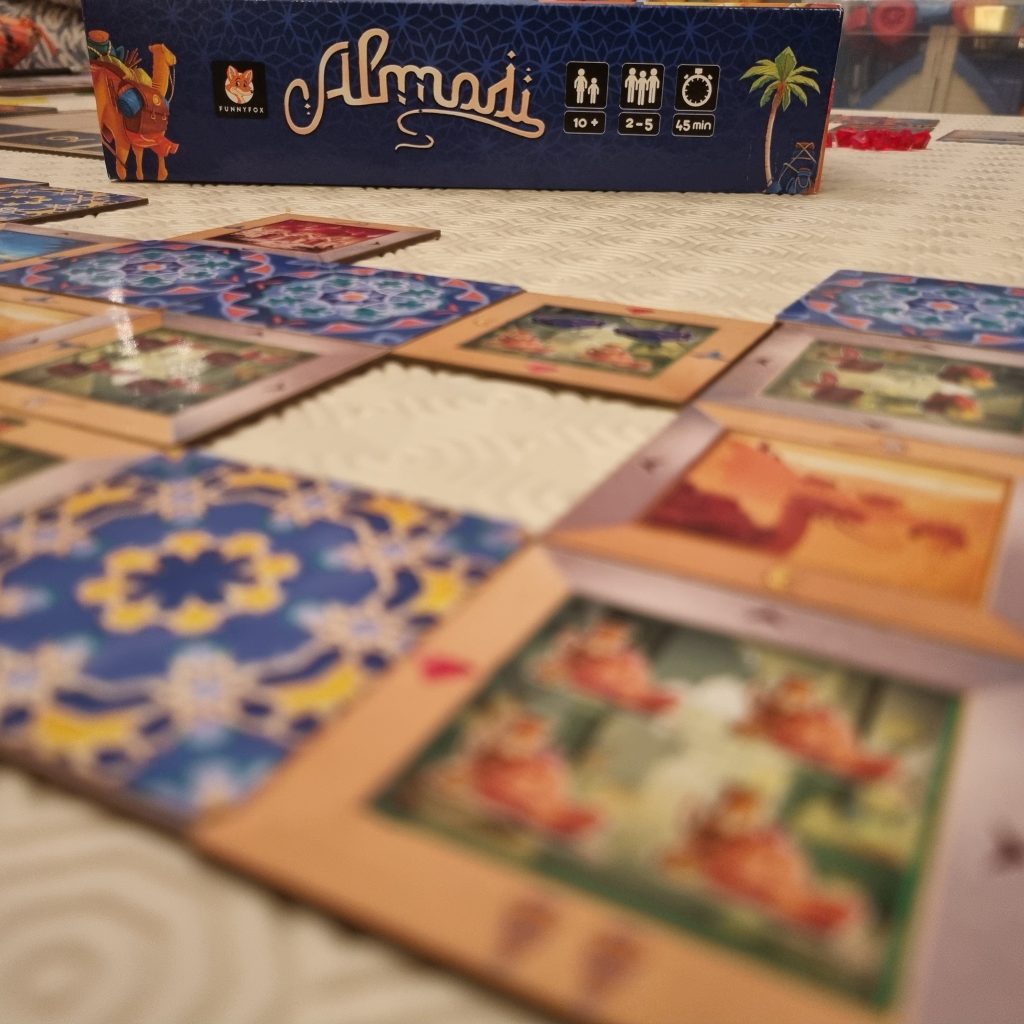Building the best Arabian realm just got perfectly puzzly! Thanks to Hachette Board Games UK, Almadi, from French publisher, Funnyfox, is about to hit the UK. And, like a cool drink on a sizzling day, I am guzzling this game down!
Publisher: Funnyfox Games, Hachette Board Games UK
Designer: Mathieu Bossu, François Gandon
Artist: Victor Dulon
Release Date: 2021
2-5 Players
Age: 10+
30-40 mins
Favouritefoe score: 9.5/10
* Spatial * Puzzle *Tile Laying * Scoring Objectives * Set Collection * Tableau Building * Combo-tastic *
ALMADI
Read on, friends, and Ill tell you an Arabian tale!
Tile Tales!
First and foremost, Almadi is a tile laying, tableau building game. You play Sultans who are building new realms replete with palaces, markets, oasis, and, of course, plenty of camels.
Each tile represents one of these 4 “Landscapes”, and each turn you simply pick one tile from an open choice of two. They are set out in 4 rows on the main board. But, if you pick one from row 1 on your turn, then it must be placed in the corresponding row in your own tableau. If there are any tiles in that row already, then this new tile must be placed adjacent to the last one. You do this 16 times, and whoever has the most points art the end wins.
So far, so simple……
But, if you look closely at any tile, you will see small icons on each side. Some are simply arrows. Others, however, are red rubies, market stalls, urns, crescent moons, hammers, and even Genies on flying carpets.
What do these little details mean? Therein lie the secret to this Arabian ace!

Sandy Set Up!
But, before revealing any more details, you need to set the sandy scene. And, like a sunset in the desert, it is over and done in just a few minutes.
Having placed the main board and the pile of shuffled Landscape tiles in easy reach, two tiles are revealed and placed along the rows numbered 1-4. The rest are placed face down in a stack ready to replenish those taken each turn. Each player is then given their board off of which they will build their own tableau over the course of the game.
Once that’s done, it’s time to sort out some goodies and pick some scoring objectives.. After all, points don’t just grow on palm trees!
Firstly, place the pile of red rubies, mosaics, and market cards in easy reach. Then randomly select one scoring objective for each Landscape type, as well as a general (spatial) one, and place these face up next to the main board.
In a rather upside down way, I think it is probably easier to explain how to play Almadi by going through the end-game scoring process. And that is because the scoring is the special sauce here.
The scoring is what makes this game puzzle perfection. What raises it above and beyond anything I thought before cracking the lid. And, although scoring may look like a lot to remember in the beginning, you’ll soon be a master at realm real estate planning (and there’s a handy player aid until you do!).

Scorching Scoring!
So, you’re a Realm Real-Estater and you’re hungry for points. Well, my friend, you are in luck. Because, in Almadi, there are eleventy-billion ways to score points! But, they can also be lost at your own doing, as well as effectively stolen by your Oasis creating opponents! Pilfering Palm Trees!
is it me, or did the temperature just go up in here???
Well let’s start with how to win points. Effectively, the main ways are set out on the scoring objectives you selected at random at the very beginning. They may relate to having a certain number of urns or rubies at end game, or placing certain Landscapes in specific configurations. With so many objectives available, there is a handy glossary in the back of the rule book should you get stuck. Once familiar with the types, we easily recognised the slight variants across the range, though.
In order to achieve these objectives, however, you need to do three things;
- “Activate” a crescent moon and “reserve” your objective of choice by placing it near your board;
- Satisfy the requirement over a series of turns; and then
- Fulfil the objective and take the objective card before someone else has the chance to steal it from you

Heat Activation!
Activation is basically how you get anything in Almadi, and it’s simple to do. On your turn, you select a tile from a row on the main board, and you place it on the appropriate row in your tableau.
In doing so, you’ll be lining up any arrows and icons on either the tile you picked, or on the tile you’re placing next to. Once an arrow is pointing at something (other than another arrow), that icon is effectively activated. If it is a ruby, you get to take one from the pile. If it is a hammer, you’ll take a mosaic tile etc.
Now, if you activate a Genie, be warned; things are about to get very exciting indeed! Those little blue beauties allow you to move a tile already placed into another position on your tableau! And, if you are sneaky, the combos then start falling into place. Ahhhhhh……..
Already activated a ruby? Well, why not Genie up and move that tile next to one with an arrow wide open for re-activation. After all, once you’ve banked a ruby, you can’t lose it. Got an arrow pointing to an urn that would work perfectly elsewhere? Use your Genie to move it! And with three possible Genie moves each turn (so long as they are activated through movement), the potential to bank a handful of hammers, mosaics, market goods, and rubies is huge!
BEWARE, however. The desert can be a harsh place. Because, unlike Rubies, urns (and Genies) are dynamic. This means that you only score for the ones you’re pointing to at end game. Three turns in, you might have a lovely collection of 9 ceramics. But, if you have done the tile tussle and moved them around, you may only have two active ceramics at the end! Dusty Doo-dahs!
Similarly, the more you shuffle things around, the more you could be moving away from a reserved objective. This not only gives opponents the chance to steal it (if they rate their chances of success, but could also expose you to negative points if you fail to achieve it by game end!
On top of that, you could also be scuppering your chances of scoring points for being a Sultan of all things spatial. If you recall, I mentioned eleventy billion ways to score points. Well, I haven’t forgotten. As well as objectives, certain Landscapes score points based on where they are in relation to other types. This could be groups of the same kind (because who wouldn’t want the biggest oasis on the block?!), or adjacency bonuses – mamma needs markets to kit out her palaces, so be sure place them in proximity for scoring purposes.
Camels are also particularly clever creatures. You may have noticed that each market Landscape tile contains 4 goods. The goods cards also show two other good types. Well, quite sensibly, if you’re maxing out on markets, you’ll need to be able to transport those to a market to sell. So, be sure to place enough camels, or else those goods will earn you nothing at end game!

Awesome Arabians!
Another element of Almadi is the addition of Characters who, for a price, can award powers and abilities during the game. Now, you will lose rubies to activate them, but they could prove to be worth more than their weight in glorious gems. And some are quite powerful given their cost to effect ratio!
Sand-sational!
This game tickles my brain. Scratch that; it itches my grey matter like sand in my pants! But, like all gaming gluttons for punishment, that lingering sensation is a wonderful thing! I want to sit there, eyes scanning, fingers hovering, primed but not ready to pick and place.
I love the trade-offs between nabbing a prime tile at a critical moment, but losing out on a bunch of other options. The dynamic scoring raises this up even further when you know you’ll be sacrificing something you might never get back and opening the door for others to score! Always conscious that that you need to reserve and fulfil objectives before others steal them is a pressure of the most pleasurable kind!
Yes, Almadi has an element of luck – the tiles and objectives are picked at random. But, with so much mitigation potential through tile manipulation and combo-moves, most of the randomness is blown away like sand on a windy day!

I should say that the copy I have played is a preview, and so some of the components could change when it hits store shelves. But the tiles were nice and thick, and the cards were good, glossy numbers. The scoring objectives could perhaps be a little larger, but maybe I just need better glasses! I also didn’t have the rule book, so DIY downloaded a copy. But it was easy to follow and has a great glossary for objectives and help with scoring.
To be honest, I am struggling to think of anything in particular that I would change about Almadi. It has shot into my top tile laying, spatial, puzzly games and It’s unlikely to leave that sandy stable! Actually, it would have been very cool to have a solo mode – something simple to mimic a 2 player experience (which is excellent!) like Cascadia or Calico. But, perhaps a very clever fan will post something on BGG one day soon!
[Please note that a copy of this game was kindly provided by the publishers for review. I am not paid for my comments, however, and all opinions are my own].








